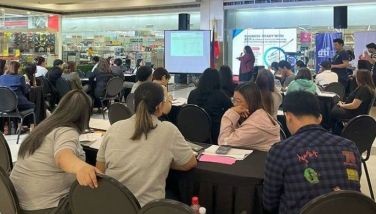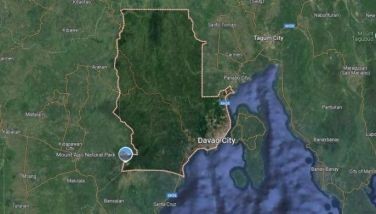Clogged

The southwest monsoon enhanced by Typhoon Carina actually dumped more water in a day that the unforgettable Typhoon Ondoy did.
Metro Manila was inundated, although not as severely as it was during Ondoy. A major reason for this was that the major waterways in the region were dredged as part of the public service program of San Miguel Corporation.
The nation’s largest conglomerate has spent over P3 billion on this dredging program. The Pasig, Tullahan and San Juan rivers were cleared and deepened, along with several waterways in Central Luzon.
While the major rivers were cleared by the San Miguel operation, the smaller tributaries were clogged with trash. The airport runway was flooded because the trash-filled Parañaque River was not draining efficiently.
No amount of flood-control investments will cure the problem for as long as trash is dumped on our waterways. Alongside our flood-control strategy, we ought to devise a decisive trash disposal strategy for our congested metropolis. Trash is dumped on the waterways because there is no reliable collection and disposal system in this urban jungle.
Although required by law, the Metro area has no sanitary landfill. We used to dump our trash at the Smokey Mountain area, then in crude landfills in Navotas and the Payatas area. Now we ferry the trash all the way to San Mateo or even farther away at great cost.
When President BBM inspected the inundated areas, he concluded that we have a waste management problem. No strategy has yet been announced about what we intend to do about this.
While we fret about the lack of a safe waste disposal site for the metropolis, the BCDA announced the Kalangitan Engineered Sanitary Landfill in Capas, Tarlac will be shut down as soon as Oct. 5, 2024. This does not seem right.
Kalangitan is the only technically compliant sanitary landfill in the whole region. It serves, apart from the Subic and Clark economic zones, over 150 local governments in Central and Northern Luzon. The landfill takes in 3,000 tons of waste each day from as far north as Cordilleras.
Where will all the trash go?
BCDA points to “alternative” sites in Porac and Floridablanca in Pampanga province. Both sites are equally small and inaccessible. They do not comply with the enginering requirements for a sanitary landfill.
If Kalangitan is shut down, a garbage crisis will explode in Central and Northern Luzon. Imaginably, 3,000 tons of waste could be dumped on the river systems each day to cause even more severe flooding.
The DENR should have a word on this matter.
Psy-ops
Reuters did painstaking research on the disinformation campaign mounted by the US Defense Department against China-made Sinovac COVID vaccines at the height of the pandemic. When their exposé was published, US defense authorities conceded the campaign did happen.
Sen. Imee Marcos called this operation “evil, wicked, dangerous, unethical.” She wants a thorough inquiry to see if this campaign violated international law and if the country had any legal recourse.
Because of the US disinformation campaign, many were hesitant to avail of the China-made vaccines. Heaven knows how many of the vaccine hesitant perished. About 37,000 Filipinos died because of COVID-19.
While several countries were frantically developing vaccines, then president Rodrigo Duterte personally appealed to Chinese President Xi Jinping for allocations. Beijing assured the widest dissemination of its vaccines.
The World Health Organization eventually certified the China-made vaccines. Although these were slightly less effective than other vaccine varieties subsequently developed, the whole virus vaccines Sinovac and Sinopharm were deemed safer. Most important, the China-made vaccines were the only ones available in the initial stages as the Western countries hoarded the spike protein vaccines they produced to protect their populations first.
Many Filipinos availed of the China-made vaccines for their first immunization. Later, when Pfizer vaccines became available, we took them for the second round. According to Dr. Edsel Salvana, this combination actually worked better. The Philippines suffered immensely less casualties per million than the US. Our death rate per million put us 130th in the world because Filipinos, in the main, were more receptive to science than the Americans.
Nevertheless, US disinformation about the China-made vaccines was conducted during a time we were already experiencing high vaccine hesitancy because of the unfortunate Dengvaxia controversy that happened before COVID-19 swept the globe. This magnified the adverse impact of American disinformation.
The US defense officials behind this disinformation campaign were thinking in narrow military terms. They did not want China’s vaccine diplomacy to gain ground. But they mounted this campaign without regard for saving lives among populations threatened by the pandemic.
The Reuters investigative report found out that the callous disinformation campaign was carried out largely on social media by a private defense contractor. There should be a way to hold this contractor accountable for spreading lies with the intention of limiting public acceptance of direly needed vaccines.
Likewise, we should demand from the US government a full apology for conducting a disinformation campaign inimical to the best interests of our people. Rules prohibiting this sort of unfriendly campaigns ought to be put on the table.
We need a more comprehensive national conversation on this matter – especially because most Filipinos see the US as an ally and a friend. Rising regional tensions make us more vulnerable to disinformation campaigns from all sides.
We need to be even more vigilant.
- Latest
- Trending




























